Introduction
This report provides background information and issues for Congress on the John Lewis (TAO-205) class oiler shipbuilding program, a program to build a new class of 20 fleet oilers for the Navy. The Navy's proposed FY2020 budget requests the procurement of the fifth and sixth ships in the program.
Issues for Congress regarding the TAO-205 program include the following: whether to approve, reject, or modify the Navy's FY2020 procurement funding request for the program; the number of oilers the Navy will require in coming years to support its operations; and whether to encourage or direct the Navy to build TAO-205s with more ship self-defense equipment than currently planned by the Navy. Decisions that Congress makes regarding the program could affect Navy capabilities and funding requirements and the U.S. shipbuilding industrial base.
For an overview of the strategic and budgetary context in which the TAO-205 program and other Navy shipbuilding programs may be considered, see CRS Report RL32665, Navy Force Structure and Shipbuilding Plans: Background and Issues for Congress, by Ronald O'Rourke.
Background
Navy Fleet Oilers
Role of Fleet Oilers
The primary role of Navy fleet oilers is to transfer fuel to Navy surface ships that are operating at sea, so as to extend the operating endurance of these surface ships and their embarked aircraft. Fleet oilers also provide other surface ships with lubricants, fresh water, and small amounts of dry cargo. Fleet oilers transfer fuel and other supplies to other surface ships in operations called underway replenishments (UNREPs). During an UNREP, an oiler steams next to the receiving ship and transfers fuel by hose (see Figure 1, Figure 2, and Figure 3).1
Oilers are one kind of Navy UNREP ship; other Navy UNREP ships include ammunition ships, dry cargo ships, and multiproduct replenishment ships. The Navy's UNREP ships are known more formally as the Navy's combat logistics force (CLF). Most of the Navy's CLF ships are operated by the Military Sealift Command (MSC).
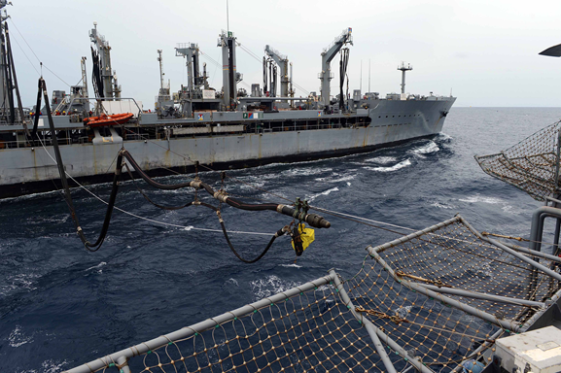 |
|
Source: Navy photo accessed May 5, 2014, at http://www.navy.mil/view_image.asp?id=163895. The Navy states that the photo is dated October 24, 2013, and shows the oiler Tippecanoe (TAO-199) extending its fuel probe to the Aegis cruiser USS Antietam (CG-54), a part of the George Washington (CVN-73) Carrier Strike Group, in the South China Sea. |
Navy oilers carry the designation TAO (sometimes written as T-AO). The T means that the ships are operated by MSC with a mostly civilian crew; the A means it is an auxiliary ship of some kind; and the O means that it is, specifically, an oiler.
Although the role of fleet oilers might not be considered as glamorous as that of other Navy ships, fleet oilers are critical to the Navy's ability to operate in forward-deployed areas around the world on a sustained basis. The U.S. Navy's ability to perform UNREP operations in a safe and efficient manner on a routine basis is a skill that many other navies lack. An absence of fleet oilers would significantly complicate the Navy's ability to operate at sea on a sustained basis in areas such as the Western Pacific or the Indian Ocean/Persian Gulf region. The Navy states that
the ability to rearm, refuel and re-provision our ships at sea, independent of any restrictions placed on it by a foreign country, is critical to the Navy's ability to project warfighting power from the sea.
As the lifeline of resupply to Navy operating forces underway, the ships of the Navy's Combat Logistic Force (CLF) enable Carrier Strike Groups and Amphibious Ready Groups to operate forward and remain on station during peacetime and war, with minimal reliance on host nation support.2
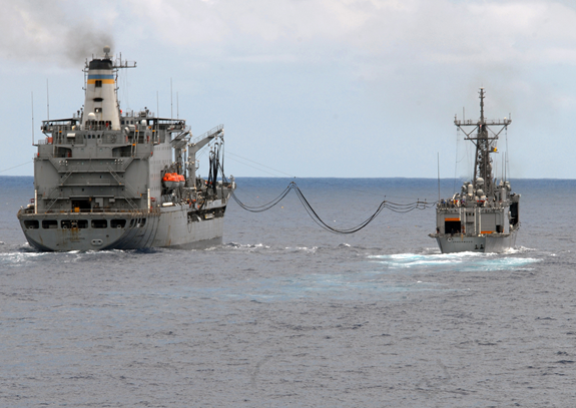 |
|
Source: Navy photo accessed May 5, 2014, at http://www.navy.mil/view_image.asp?id=61415. The Navy states that the photo is dated July 13, 2008, and shows the oiler Leroy Grumman (TAO-195) refueling the frigate Underwood (FFG-36) during an exercise with the Iwo Jima (LHD-7) Expeditionary Strike Group in the Atlantic Ocean. |
Existing Henry J. Kaiser (TAO-187) Class Oilers
The Navy's existing force of fleet oilers consists of 15 Henry J. Kaiser (TAO-187) class ships (Figure 4).3 These ships were procured between FY1982 and FY1989 and entered service between 1986 and 1996. They have an expected service life of 35 years; the first ship in the class will reach that age in 2021. The ships are about 677 feet long and have a full load displacement of about 41,000 tons, including about 26,500 tons of fuel and other cargo. The ships were built by Avondale Shipyards of New Orleans, LA, a shipyard that eventually became part of the shipbuilding firm Huntington Ingalls Industries (HII). HII subsequently wound down Navy shipbuilding operations at Avondale, and the facility no longer builds ships. (HII continues to operate two other shipyards that build Navy ships.)
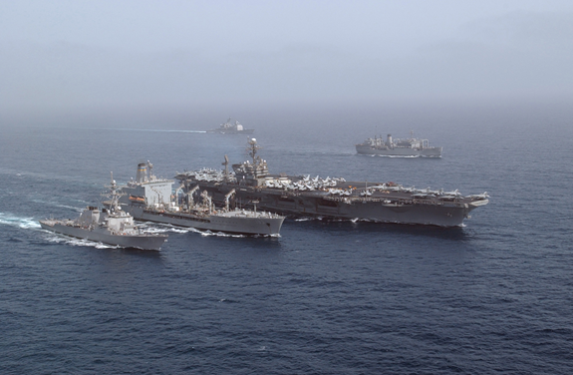 |
|
Source: Navy photo accessed May 5, 2014, at http://www.navy.mil/view_image.asp?id=1737. The Navy states that the photo is dated June 19, 2002, and shows the oiler Walter S. Diehl (TAO-193), at center, conducting simultaneous UNREPs with the aircraft carrier John F. Kennedy (CV-67) and the Aegis destroyer Hopper (DDG-70). CV-67, a conventionally powered carrier, has since retired from the Navy, and all of the Navy's aircraft carriers today are nuclear powered. Even so, Navy oilers continue to conduct UNREPs with Navy aircraft carriers to provide fuel for the carriers' embarked air wings. |
TAO-205 Program
Program Name
The TAO-205 class program was originally called the TAO(X) program, with the (X) meaning that the exact design of the ship had not yet been determined. On January 6, 2015, then-Secretary of the Navy Ray Mabus announced that ships in the class will be named for "people who fought for civil rights and human rights,"4 and that the first ship in the class, TAO-205, which was procured in FY2016, will be named for Representative John Lewis.5 The class consequently is now known as the John Lewis (TAO-205) class.6
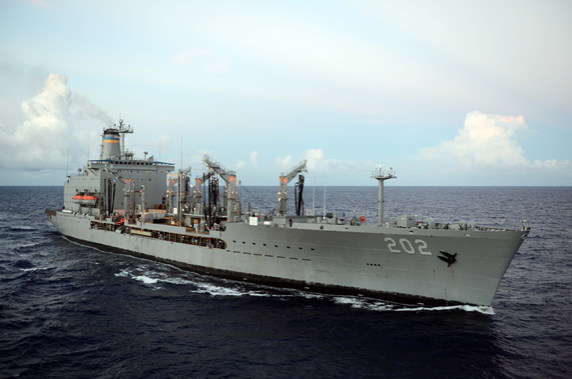 |
|
Source: U.S. Navy image accessed April 14, 2014, at http://www.navy.mil/management/photodb/photos/130703-N-TG831-240.jpg. (The oilers shown in Figure 1, Figure 2, and Figure 3 are also Kaiser-class class oilers.) |
Quantity
As part of its goal for achieving a fleet of 355 ships, the Navy wants to procure a total of 20 TAO-205 class ships. The required number of oilers largely depends on the numbers and types of other surface ships (and their embarked aircraft) to be refueled, and the projected operational patterns for these ships and aircraft.7
Schedule
The first TAO-205 class ship was procured in FY2016, the second in FY2018, and the third and fourth in FY2019. The Navy's FY2020 five-year (FY2020-FY2023) shipbuilding plan calls for procuring the next seven ships in the class in annual quantities of 2-1-1-2-1. The Navy's FY2020 30-year (FY2020-FY2049) shipbuilding plan calls for procuring the remaining nine ships in the program at a rate of one per year starting in FY2025. The first TAO-205 is scheduled for delivery in November 2020.
Funding
Table 1 shows procurement funding for the TAO-205 program in the Navy's FY2020 budget submission. The Navy's FY2020 budget submission estimates the total procurement cost of the 20 planned TAO-205s at $12,196.1 million (i.e., about 12.2 billion) in then-year dollars, or an average of $609.8 million each. Since the figure of $12,196.1 million is in then-year dollars, it incorporates estimated annual inflation rates for TAO-205s to be procured out to FY2033.
|
FY20 (req.) |
FY21 (proj.) |
FY22 (proj.) |
FY23 (proj.) |
FY24 (proj.) |
|
|
Procurement |
981.2 |
439.5 |
447.6 |
1,025.8 |
482.3 |
|
Advance procurement (AP) funding |
73.0 |
73.0 |
74.0 |
75.5 |
77.0 |
|
Cost to complete |
3.7 |
0 |
0 |
0 |
0 |
|
TOTAL |
1,057.9 |
512.6 |
521.6 |
1,101.3 |
559.3 |
|
(Procurement quantity) |
(2) |
(1) |
(1) |
(2) |
(1) |
|
Estimated unit procurement cost of ship(s) being procured that year |
528.1 |
512.6 |
520.6 |
549.9 |
557.8 |
Source: Navy FY2020 budget submission.
Ship Design and Capabilities
The TAO-205 class design (Figure 5) will have capabilities similar to those of the Kaiser-class ships, and will rely on existing technologies rather than new technologies. To guard against oil spills, TAO-205s are to be double-hulled, like modern commercial oil tankers, with a space between the two hulls to protect the inner hull against events that puncture the outer hull. (The final Kaiser-class ships are double-hulled, but earlier ships in the class are single-hulled.)
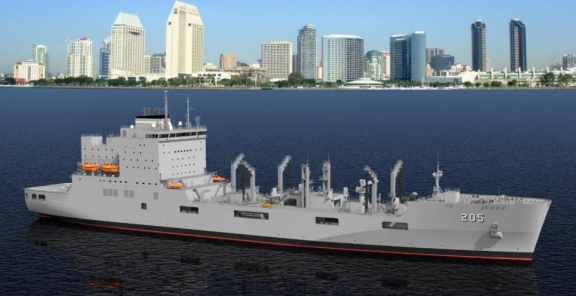 |
|
Source: "US Navy Picks General Dynamics to Build First Six T-AO 205 Replenishment Oilers," NavalToday.com, July 1, 2016, which credits the image to GD/NASSCO. The background shows the skyline of San Diego, where GD/NASSCO is located. |
Builder
TAO-205s are being built by General Dynamics/National Steel and Shipbuilding Company (GD/NASSCO) of San Diego, CA, a shipyard that builds Navy auxiliaries and DOD sealift ships.
Combined Solicitation Limited to Two Builders8
On June 25, 2015, the Navy, as part of its acquisition strategy for TAO-205 program, issued a combined solicitation consisting of separate Requests for Proposals (RFPs) for
- the detailed design and construction (DD&C) of the first six TAO-205s;
- the DD&C in FY2017 (and also procurement of long lead-time materials in FY2016) for an amphibious assault ship called LHA-8 that the Navy procured in FY2017; and
- contract design support for the LPD-17 Flight II program (previously called the LX[R] program), a program to procure a new class of 13 amphibious ships.9
The Navy limited bidding in this combined solicitation to two bidders—Ingalls Shipbuilding of Huntington Ingalls Industries (HII/Ingalls) and GD/NASSCO—on the grounds that these are the only two shipbuilders that have the capability to build both TAO-205s and LHA-8.
Under the Navy's plan for the combined solicitation, one of these two yards was to be awarded the DD&C contract for the first six TAO-205s, the other yard was to be awarded the DD&C contract (and procurement of long lead-time materials) for LHA-8, and the shipyard with the lowest combined evaluated price was to receive a higher profit on its DD&C contract10 and was to be awarded the majority of the LPD-17 Flight II contract design engineering man-hours.
Block Buy Contract Awarded to GD/NASSCO
On June 30, 2016, the Navy announced its awards in the above-described combined solicitation, awarding a fixed price incentive block buy contract for the DD&C of the first six TAO-205s to GD/NASSCO. (The Navy awarded the contract for the DD&C of LHA-8 to HII/Ingalls.11 HII/Ingalls was also awarded the majority of the LPD-17 Flight II contract design engineering man-hours.)12 The Navy was granted authority for using a block buy contract to procure the first six TAO-205s by Section 127 of the FY2016 National Defense Authorization Act (S. 1356/P.L. 114-92 of November 25, 2015).
It was earlier estimated that the block buy contract would reduce the procurement cost of the second through sixth TAO-205s by an average of about $45 million each, compared to costs under the standard or default DOD approach of annual contracting.13 The Navy states that about $35 million of the $45 million in per-ship savings will come from using advance procurement (AP) funding for batch-ordering TAO-205 components. The Navy states that this use of AP funding could have occurred under annual contracting, and that the savings that are intrinsic to the block buy contract are thus about $10 million per ship.14
U.S. Content Requirement for Certain Components
Section 8117 of the FY2019 Appropriations Act (Division A of H.R. 6157/P.L. 115-245 of September 28, 2018) states the following:
Sec. 8117. None of the funds provided in this Act for the TAO Fleet Oiler program shall be used to award a new contract that provides for the acquisition of the following components unless those components are manufactured in the United States: Auxiliary equipment (including pumps) for shipboard services; propulsion equipment (including engines, reduction gears, and propellers); shipboard cranes; and spreaders for shipboard cranes.
May 2019 GAO Report
The Appendix presents the Government Accountability Office's (GAO's) assessment of the TAO-205 class program from GAO's annual report surveying DOD major acquisition programs.
FY2020 Procurement Funding Request
The Navy's proposed FY2020 budget requests the procurement of the 5th and 6th ships in the program. The Navy estimates the combined procurement cost of the two ships at $1,056.3 million, or an average of $528.1 million each. The two ships have received $75.0 million in prior-year advance procurement (AP) funding, and the Navy's proposed FY2020 budget requests the remaining $981.2 million in procurement funding needed to complete the two ships' estimated combined procurement cost. The Navy's proposed FY2020 budget also requests $73.0 million in AP funding for TAO-205s to be procured in future fiscal years, and $3.7 million in cost-to-complete procurement funding to cover cost growth on TAO-205s procured in prior fiscal years, bringing the total FY2020 procurement funding request for the TAO-205 program (aside from outfitting and post-delivery costs) to $1,057.9 million.
Issues for Congress
FY2020 Procurement Funding
One issue for Congress is whether to approve, reject, or modify the Navy's FY2020 procurement funding request for the TAO-205 program. In assessing this issue, Congress may consider, among other things, whether the Navy has accurately priced the work that it is requesting to fund in FY2020.
Required Number of Oilers
Another issue for Congress concerns the number of oilers the Navy will require in coming years to support its operations. The Navy is implementing a new operational concept, called Distributed Maritime Operations (DMO), that could lead to the development of a fleet with larger numbers of individually smaller ships, and to more-widely dispersed Navy operations. DMO could affect requirements for Navy logistics, including oilers. The Navy states that
Recapitalizing the auxiliary and sealift fleet in support of DMO has become a top priority. The initial reviews of the requirements to support this operational maritime concept indicate potential growth across the five lines of effort: refuel, rearm, resupply, repair, and revive. Coincident is the review of the level of effort needed to distribute logistics into a contested maritime environment following safe transfer by the logistics fleet—smaller, faster, multi-mission transports likely resident within the future battle force. The work to fully flesh out the requirement is ongoing, but the aggregate is expected to be no less than the current requirement, reinforcing the urgency to recapitalize the current fleet.15
An August 2017 GAO report states the following:
The readiness of the surge sealift and combat logistics fleets has trended downward since 2012. For example, GAO found that mission-limiting equipment casualties—incidents of degraded or out-of-service equipment—have increased over the past 5 years, and maintenance periods are running longer than planned, indicating declining materiel readiness across both fleets....
The Navy has not assessed the effects of widely distributed operations, which could affect the required number and type of combat logistics ships. The Navy released its new operational concept of more widely distributed operations—ships traveling farther distances and operating more days to support a more distributed fleet—in 2017. The Navy has not assessed the effects that implementing this concept will have on the required number and type of combat logistics ships. These effects could be exacerbated in the event that the Navy is less able to rely on in-port refueling—which has comprised about 30 percent of all refuelings over the past 3 years—placing greater demand on the combat logistics fleet. Given the fleet's dependence on the combat logistics force, waiting until 2019 or 2020 to conduct an assessment, as planned, could result in poor investment decisions as the Navy continues to build and modernize its fleet. Furthermore, without assessing the effects of widely distributed operations on logistics force requirements and modifying its force structure plans accordingly, the Navy risks being unprepared to provide required fuel and other supplies.16
TAO-205 Ship Self-Defense Equipment
Another issue for Congress is whether to encourage or direct the Navy to build TAO-205s with more ship self-defense equipment than currently planned by the Navy. The issue relates to how changes in the international security environment might affect how the Navy operates and equips its underway replenishment ships.
During the Cold War, the Navy procured underway replenishment ships to support a two-stage approach to underway replenishment in which single-product "shuttle" ships (such as oilers, ammunition ships, and dry stores ships) would take their supplies from secure ports to relatively safe midocean areas, where they would then transfer them to multiproduct "station" ships called TAOEs and AORs. The TAOEs and AORs would then travel to Navy carrier strike groups operating in higher-threat areas and transfer their combined supplies to the carrier strike group ships. As a result, single-product shuttle ships were equipped with lesser amounts of ship self-defense equipment, and TAOEs and AORs were equipped with greater amounts of such equipment.
When the Cold War ended and transitioned to the post-Cold War era, threats to U.S. Navy ships operating at sea were substantially reduced. As a consequence, the amount of ship self-defense equipment on the TAOEs and AORs was reduced, and a single-stage approach to underway replenishment, in which oilers and dry stores ships took supplies from secure ports all the way to carrier strike group ships, was sometimes used.
Now that the post-Cold War era has transitioned to a new strategic environment featuring renewed great power competition with countries like China and Russia,17 and a consequent renewal of potential threats to U.S. Navy ships operating at sea, the question is whether TAO-205s should be equipped with lesser amounts of ship self-defense equipment, like oilers were during both the Cold War and post-Cold War eras, or with greater amounts of ship self-defense equipment, like TAOEs and AORs were during the Cold War. Building TAO-205s with more ship self-defense equipment than currently planned by the Navy could increase TAO-205 procurement costs by tens of millions of dollars per ship, depending on the amount of additional ship self-defense equipment.
Section 1026 of the FY2016 National Defense Authorization Act (S. 1356/P.L. 114-92 of November 25, 2015) required an independent assessment of the Navy's combat logistics force ships. The report was delivered to Congress in February 2016. A copy of the report was posted by the media outlet Politico on March 11, 2016. The report states the following:
The T-AO(X) will only have a limited capability to defeat a submarine launched torpedo attack and no capability to defeat a missile attack. When delivered, the TAO(X) will have:
—[the] NIXIE Torpedo Countermeasure System [for decoying certain types of torpedoes]
—[the] Advanced Degaussing System (Anti-Mine) [for reducing the ship's magnetic signature, so as to reduce the likelihood of attack by magnetically fused mines]
When required, the T-AO(X) will also have ability to embark Navy Expeditionary Combat Command Expeditionary Security Teams (EST). The ESTs will embark with several crew served weapons and are designed to provide limited self-defense against a small boat attack.
The T-AO(X) will have Space, Weight, Power and Cooling (SWAP-C) margins for future installations of the following systems:
—[the] Close In Weapon System (CIWS) or SeaRAM (Rolling Airframe Missile) [for defense against missile attack]
—[the] Anti-Torpedo Torpedo Defense System (ATTDS) [for destroying torpedoes]
Even after the installation of a CIWS or ATTDS, if the T-AO(X) was to operate in anything other than a benign environment, the ship will require both air and surface escorts.
The decision to rely on [other] Fleet assets to provide force protection [i.e., defense against attacks] for the T-AO(X) was validated by the JROC [in June 2015].18
Legislative Activity for FY2020
Summary of Congressional Action on FY2020 Funding
Table 2 summarizes congressional action on the Navy's request for FY2020 procurement funding for the TAO-205 program.
Table 2. Congressional Action on FY2020 Procurement Funding
Millions of dollars, rounded to nearest tenth
|
Request |
Authorization |
Appropriation |
|||||
|
HASC |
SASC |
Conf. |
HAC |
SAC |
Conf. |
||
|
Procurement |
981.2 |
607.2 |
981.2 |
981.2 |
981.2 |
||
|
Advance procurement (AP) |
73.0 |
0 |
73.0 |
73.0 |
73.0 |
||
Source: Navy FY2020 budget submission, committee and conference reports, and explanatory statements on FY2019 National Defense Authorization Act and FY2020 DOD Appropriations Act.
Notes: HASC is House Armed Services Committee; SASC is Senate Armed Services Committee; HAC is House Appropriations Committee; SAC is Senate Appropriations Committee; Conf. is conference agreement.
FY2020 National Defense Authorization Act (H.R. 2500/S. 1790)
House
The House Armed Services Committee, in its report (H.Rept. 116-120 of June 19, 2019) on H.R. 2500, recommended the funding levels shown in the HASC column of Table 2. The recommended net reduction of $374.0 million for procurement funding includes a reduction of $447.0 million for "Full funding early to need" and an increase (a transfer from the advance procurement [AP] funding line) of $73.0 million. The recommended reduction of $73.0 million (the entire requested amount for advance procurement (AP) funding is for transfer to the procurement funding line. (Page 379) H.Rept. 116-120 states:
John Lewis fleet oiler replenishment ships
The budget request included $1.1 billion for procurement of the John Lewis (T–AO) class fleet replenishment oiler. The committee continues to be supportive of the Navy's plan to procure the T–AO oilers. This ship will operate as the primary fuel pipeline from resupply ports to station ships, providing replenishment of bulk petroleum products, dry stores/packaged cargo, fleet freight, mail, and personnel to combatants and support forces underway. As a secondary mission, the T–AO will accompany and stay on-station with the carrier strike group to provide replenishment as required to customer ships. This ship will be a critical leg of the Navy's logistical framework. The committee understands that the Navy chose to accelerate the procurement of one T–AO from fiscal year 2021 to fiscal year 2020 but due to long lead procurement items, this ship will not start construction until 2021.
Therefore, the committee recommends $607.2 million, a reduction of $447.0 million, for the T–AO program. (Page 19)
Section 806 of H.R. 2500 as reported by the committee states:
SEC. 806. REQUIREMENT THAT CERTAIN SHIP COMPONENTS BE MANUFACTURED IN THE NATIONAL TECHNOLOGY AND INDUSTRIAL BASE.
(a) Additional Procurement Limitation.--Section 2534(a) of title 10, United States Code, is amended by adding at the end the following new paragraph:
``(6) Components for auxiliary ships.--Subject to subsection (k), the following components:
``(A) Auxiliary equipment, including pumps, for all shipboard services.
``(B) Propulsion system components, including engines, reduction gears, and propellers.
``(C) Shipboard cranes.
``(D) Spreaders for shipboard cranes.''.
(b) Implementation.--Such section is further amended by adding at the end the following new subsection:
``(k) Implementation of Auxiliary Ship Component Limitation.-- Subsection (a)(6) applies only with respect to contracts awarded by the Secretary of a military department for new construction of an auxiliary ship after the date of the enactment of the National Defense Authorization Act for Fiscal Year 2020 using funds available for National Defense Sealift Fund programs or Shipbuilding and Conversion, Navy. For purposes of this subsection, the term `auxiliary ship' does not include an icebreaker.''.
H.Rept. 116-120 also states:
Sourcing of Domestic Components for U.S. Navy Ships
The committee is concerned with the sourcing of non-domestic components on U.S. Navy ships. The committee directs the Secretary of the Navy to provide a report to the congressional defense committees by December 1, 2019, on the feasibility of sourcing domestic components such as: auxiliary equipment, including pumps; propulsion system components, including engines, reduction gears, and propellers; shipboard cranes and spreaders for shipboard cranes; and other components on all Navy ships. (Page 186)
Senate
The Senate Armed Services Committee, in its report (S.Rept. 116-48 of June 11, 2019) on S. 1790, recommended the funding levels shown in the SASC column of Table 2.
FY2020 DOD Appropriations Act (H.R. 2968/S. 2474)
House
The House Appropriations Committee, in its report (H.Rept. 116-84 of May 23, 2019) on H.R. 2968, recommended the funding levels shown in the HAC column of Table 2.
Section 8108 of H.R. 2968 as reported by the committee states:
Sec. 8108. None of the funds provided in this Act for the TAO Fleet Oiler program or the FFG-Frigate program shall be used to award a new contract that provides for the acquisition of the following components unless those components are manufactured in the United States: Auxiliary equipment (including pumps) for shipboard services; propulsion equipment (including engines, reduction gears, and propellers); shipboard cranes; and spreaders for shipboard cranes.
Regarding Section 8108, a Navy information paper states in part (emphasis added):
The Navy does not agree with the proposed language in [Section 8108 of H.R. 2968 as reported by the House Appropriations Committee]. If enacted, it will result in the potential for: redesign, loss of commonality with the rest of the US Fleet, increases in cost, and delay to the FFG(X) Detail Design and Construction (DD&C) contract award. There is no direct impact on the TAO Fleet Oiler program.19
Senate
The Senate Appropriations Committee, in its report (S.Rept. 116-103 of September 12, 2019) on S. 2474, recommended the funding levels shown in the SAC column of Table 2.
Section 8108 of S. 2474 as reported by the committee states:
Sec. 8108. None of the funds provided in this Act for the TAO Fleet Oiler program shall be used to award a new contract that provides for the acquisition of the following components unless those components are manufactured in the United States: Auxiliary equipment (including pumps) for shipboard services; propulsion equipment (including engines, reduction gears, and propellers); shipboard cranes; and spreaders for shipboard cranes.
Appendix. May 2019 GAO Report
A May 2019 GAO report—the 2019 edition of GAO's annual report surveying DOD major acquisition programs—stated the following regarding the TAO-205 program:
Technology Maturity and Design Stability
The Navy has matured all Lewis class critical technologies and stabilized the ships' design. In 2014, the Navy identified three critical technologies for the Lewis class, all of which involved a new system for transferring cargo at sea. Prior to initiating detail design activities in June 2016, the Navy completed prototype tests of the critical technologies and found that they were fully mature—an approach consistent with shipbuilding best practices. In 2017, the Navy removed one critical technology—the Heavy e-STREAM cargo delivery system—from the Lewis class design. The Navy had intended to use this system to deliver F-35 Lightning II power modules. The Navy subsequently decided to deliver these by air, which precluded any need for the Heavy system.
Lead ship construction began in September 2018 with 95 percent of the ship's total design effort complete. Program officials stated that this figure meant that 100 percent of the ship's basic and functional design were by then complete—an approach consistent with best practices. Throughout detail design and now into construction, the Navy has not changed the Lewis class program's performance requirements. The Navy also leveraged commercial vessel designs to minimize design and construction risks. The Lewis class features a modern double-hull construction, an environmental-based design standard for commercial tankers, to ensure the ships can dock at ports-of-call. This design was included in the final three Kaiser class oilers.
Production Readiness
The program office has largely kept to its construction schedule to date for the first ship, but a flooding incident at a NASSCO graving dock in July 2018 has affected the delivery of future ships. The program office stated that this incident has not affected current ship fabrication activities. However, the dock's unavailability while repairs are planned and implemented has disrupted the contractor's schedule for future ships. According to the program office, the incident has resulted in some delays to certain delivery dates for ships two through six.
Other Program Issues
As part of the Navy's plan to expand the fleet, the Navy concluded that it would need an additional three Lewis class ships. The Navy's budget request for fiscal year 2019 increased its planned one-ship-per-year buy to two for fiscal years 2019, 2021, and 2023. The Congress provided appropriations for the additional fiscal year 2019 ship in support of the Navy's request. To account for the additional ships in fiscal years 2019 and 2021, the Navy plans to add two more ships to the low-rate initial production phase. Subsequently, program officials stated that they plan to compete a new contract for the remaining 12 ships using the construction knowledge gained from efforts under the existing contract.
Program Office Comments
We provided a draft of this assessment to the program office for review and comment. The program office provided technical comments, which we incorporated where appropriate. The program office stated that it continues to follow GAO shipbuilding best practices and has leveraged commercial vessel design practices to minimize risk. The program office also stated that it is currently revising its acquisition baseline to reflect the update in total quantities to 20 ships. In addition, the program office noted that, in fiscal year 2019, it fully funded the third and fourth ships and funded advance procurement for the fifth ship.20